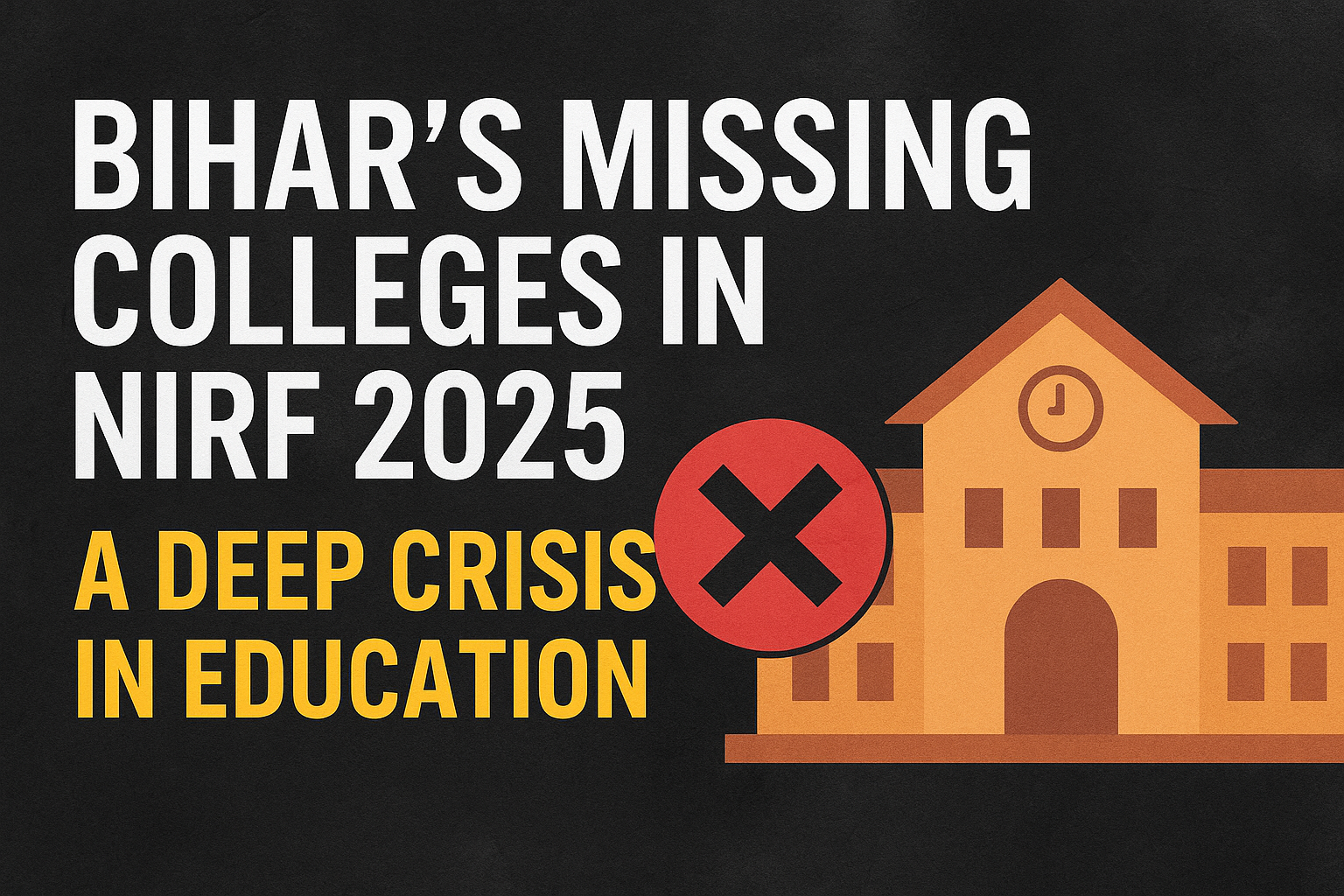
When the NIRF 2025 rankings were released, one fact stood out like a wound—not a single college or university from Bihar made it to the top list. For a state with nearly 13 crore people, this absence is more than just an oversight. It is proof of the deep crisis in Bihar’s education system, a decline that now threatens the future of millions of young minds. Rankings, after all, are not mere numbers; they reflect years of institutional effort, quality of faculty, research, and vision. Bihar’s blank space in this list exposes decades of neglect and a structural failure that is now too large to ignore.
Numbers Portray Misfortune
Bihar today has around 20 state universities and nearly 1,200 colleges. Compare this to states with smaller populations: Delhi, with less than 2 crore people, has produced institutions like Delhi University, JNU, Jamia Millia Islamia, and IIT Delhi—all ranked nationally and globally. Bihar, with seven times the population, has failed to nurture even one comparable center of excellence.
The ratio is alarming. Bihar has barely 7 colleges per lakh population, while the national average is 30 per lakh. This deficit leaves lakhs of students without access to quality higher education, forcing many to migrate to Delhi, Pune, Bengaluru, or abroad. Those who cannot migrate often settle for degrees from underfunded, poorly managed colleges where quality is an afterthought. For them, higher education becomes less about knowledge and more about survival—earning a degree that may hold little value in a competitive job market.
Why the Decline?
Bihar was once a cradle of learning, home to ancient Nalanda and Vikramshila universities, which drew scholars from across the world. Today, it represents the opposite—a symbol of neglect. The reasons are painful but clear:
- Chronic underfunding: Universities run on shoestring budgets, with outdated labs, empty libraries, and crumbling campuses.
- Faculty shortages: Thousands of teaching posts remain vacant, leaving classrooms without mentors.
- Political interference: Appointments and university governance are often dictated by politics, not merit.
- Research vacuum: Very little original research comes from Bihar’s universities, with negligible publications in reputed journals.
- Degree over learning: Institutions are reduced to certificate-producing centers rather than spaces of innovation.
This decline is not sudden—it is the result of decades of systematic apathy, where education was never treated as an investment but as an afterthought.
The Migration Trap
Every year, thousands of students from Bihar migrate out for higher education. Patna itself has become a coaching capital, not an education hub, where students prepare for exams that will take them elsewhere. This mass migration drains Bihar of talent, leaving behind a vacuum.
The irony is sharp: Bihar supplies toppers to Delhi University, IITs, and other leading institutions, yet its own universities fail to provide even the basics. Families spend fortunes to send children away, not out of ambition but out of necessity. Those left behind are trapped in a cycle of substandard education, limited opportunities, and eventual disillusionment.
What This Means for Bihar’s Future
The absence of Bihar in NIRF rankings is not just about prestige. It unfolds the layers of neglect and corruption that have eaten into the system. Without strong universities, Bihar cannot create skilled graduates, attract industries, or build research ecosystems. Weak education fuels unemployment, unemployment compels migration, and migration hollows out the state even further. The cycle is self-defeating and dangerous.
Bihar’s government must treat education as the state’s most urgent infrastructure. Roads and bridges may connect cities, but only education can connect generations to progress. More universities, better funding, independent recruitment of faculty, and investment in research are not luxuries—they are necessities. Unless these reforms take root, Bihar will continue to export its brightest minds and import its failures.
The Real Tragedy
Bihar once gave India Nalanda, a beacon for world scholarship and dialogue. That a land once revered for intellectual leadership cannot place a single university in the top 100 of its own country is not just decline—it is tragedy. It is the slow erasure of Bihar’s academic identity.
Unless urgent steps are taken, Bihar risks creating not just a generation of migrants but an entire future where education is synonymous with exile. The people of Bihar deserve better than institutions that merely distribute degrees. They deserve universities that inspire, innovate, and lead. Anything less is not just a crisis—it is a betrayal of history and of future generations.



.jpeg)





.jpeg)



.jpeg)



.jpeg)
.jpeg)
.jpeg)

